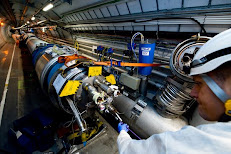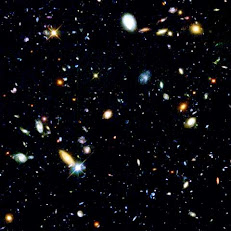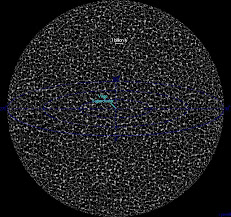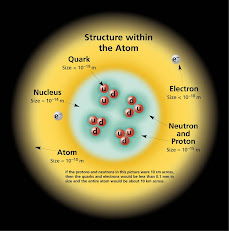VS Perdigon, Jr
Man used to say that the smallest components of matter were the atoms. That’s what the Greek philosophers deduced and John Dalton claimed – until other scientists were able to fabricate instruments that proved atoms were in fact made of electrons, neutrons and protons. Then more instruments were fabricated and it was shown that there are even more basic, or fundamental, particles. So now, we say we have known the most elementary components of matter – the baryons, leptons, mesons, gravitons and photons. Or have we?
Could what we call most elementary particles be mere results of the limitations of our instruments? If in the future man is able to fabricate better instruments, would he not discover that these current elementary particles are in turn made of more elementary ones?
Indeed, one website has this to state:1 (italics mine)
In the 1930s, it seemed that protons, neutrons, and electrons were the smallest objects into which matter could be divided and they were termed "elementary particles ". The word elementary then meant "having no smaller constituent parts", or "indivisible" -- the new "atoms", in the original sense.
Again, later knowledge changed our understanding as physicists discovered yet another layer of structure within the protons and neutrons. It is now known that protons and neutrons are made (of) quarks. Over 100 other "elementary" particles were discovered between 1930 and the present time. These elementary particles are all made from quarks and/or antiquarks. These particles are called hadrons.
Once quarks were discovered, it was clear that all these hadrons were composite objects, so only in out-dated text books are they still called "elementary". Leptons, on the other hand, still appear to be structureless.
Today, quarks and leptons , and their antiparticles , are candidates for being the fundamental building blocks from which all else is made. Particle physicists call them the "fundamental" or "elementary" particles -- both names denoting that, as far as current experiments can tell, they have no substructure.
Are Quarks and Leptons Structureless?
All we know is that quarks and leptons are smaller than 10-19 meters in radius. As far as we can tell, they have no internal structure or even any size. It is possible that future evidence will, once again, show this understanding to be an illusion and demonstrate that there is substructure within the particles that we now view as fundamental (boldface and italics mine).
The possibility that we have not said the last word on the fundamental composition of matter is evident in the very definition of “FUNDAMENTAL PARTICLE – any of a group of bodies that are at present considered to be the ultimate constituents of matter and that are classified according to such properties as charge, spin, mass”2 (boldface mine). The phrase at present considered to be denies the definition of any finality but rather stamps it with obvious tentativeness.
As we go on with the process of fabricating better and better instruments, would we not discover more and more elementary components of matter? In the end, would we not realize that matter is made of an infinity of components – components are composed of components composed of components ad infinitum?
Is it possible that we will discover such smaller components once we are able to fabricate better instruments? Is it possible that we say these are the most elementary components simply because they are what we get due to the limitations of our current instruments?
The fiction writer Michael Crichton ends his novel The Lost World with this remark: 3
It’s just theories. Human beings can’t help making them, but the fact is that theories are just fantasies. And they change. When America was a new country, people believed in something called phlogiston. You know what that is? No? Well, it doesn’t matter, because it wasn’t real anyway. They also believed that four humors controlled behavior. And they believed that the earth was only a few thousand years old. Now we believe the earth is four billion years old, and we believe in photons and electrons, and we think human behavior is controlled by ego and self-esteem. We think those beliefs are more scientific and better.
They’re still just fantasies. They’re not real. Have you ever seen self-esteem? Can you bring me one on a plate? How about photon? Can you bring me one of those?
And you never will, because those things don’t exist. No matter how seriously people take them . . . A hundred years from now, people will look back at us and laugh. They’ll say, ‘You know what people used to believe? They believed in photons and electrons. Can you imagine anything so silly?’ They’ll have a good laugh, because by then there will be newer and better fantasies.
That a fiction writer remarks thus is not an argument against the possibility of what he means. Science itself is replete with cases of erstwhile seeming ultimate truths which did not stand the test of the scientific method.
Take the case of the ancient notion of atom. The word is Greek which means indivisible. But now it can be split with such great effect as to erase a whole city in one nuclear blast.
Then there used to be caloric sometime in the late 1700’s. I once read in my college physics textbook: 4
When two systems at different temperatures are placed together, the final temperature reached by both systems is somewhere between the two starting temperatures . . . Humans have long sought for a deeper understanding of such phenomena. (sic) Up to the beginning of the nineteenth century, they were explained by postulating that a material substance, caloric, existed in every body. It was believed that a body at a high temperature contained more caloric than one at a low temperature. When the two bodies were put together, the body rich in caloric lost some to the other until both bodies reached the same temperature. The caloric theory was able to describe many processes . . . However, the concept of heat as a substance, whose total amount remained constant, eventually could not stand the test of experiment . . . It became generally understood that heat is a form of energy rather than a substance . . . Benjamin Thomson (1753-1814) made this discovery while supervising the boring of cannon for the Bavarian government.
The third case is the ether. It was thought to be the medium that carried light even through a vacuum. Sound, another form of energy (just as light is also a form of energy), travels through a medium – air. For a time, people believed that there must be “something in a vacuum” which “plays the same role for light that air does for sound.”5 “All attempts to make experimental verifications along (the belief that ether existed) failed completely . . . Albert Einstein made a second bold postulate. The speed of light is the same in all inertial frames.” Einstein showed that no ether is needed or involved.6
The fourth case is Pluto. In August 2006 this was downgraded from major to minor planet. 7
The decision to downgrade Pluto from a planet has sparked a lively debate that only proves why science is so compelling. Even universal truths can be subject to challenge and change . . . This is a great lesson for budding young scientists. Remember, Pluto's designation as a "dwarf planet" changes 76 years of science. So don't be afraid to challenge the status quo. Discovery awaits.
We see infinity in the decreasing dimension. We can observe infinity in ordinary experience.
Back in college, my teacher in Humanities I tasked us to draw “mandalas” – those graphical artworks of the Hindus. I drew a figure composed of geometric shapes in quadrants. Each quadrant was similar to the big frame – composed of more quadrants each similar to the one in the big frame. The shapes were drawn smaller and smaller but always similar to the figure in the big frame.
Then I saw a television screen showing another television screen with still another television screen within. The television screens, I realized, would be infinitely reproduced in an ever decreasing size but all of them would be contained in the actual television screen in front of me. The same observation is true with mirrors placed in front and at the back of a viewer as in a barber shop. The reflections contained in reflections form an infinite series. In both cases of the television screen and the mirror an infinity is contained in a finite object.
We can also see infinity in the increasing dimension. In the days of the ancient Greeks, the edge of the world was at the Gibraltar simply because their boats could sail only that far. By reasoning and not by use of any instrument, some Greek philosophers concluded that the earth was round. Indeed, one of them, measured the circumference of the earth just by observing shadows in a well. The Dark Ages set in and man believed in diverse errors one of which was his notion that the earth was flat. Then man built boats that ventured into the Atlantic. He said, the edge of the world was on the western Atlantic. If he sailed beyond it, his boat would fall off the earth – until the Vikings reached Greenland. But even this discovery was swallowed by ignorance then permeating medieval Europe. It took Columbus to know that seemingly the world was round – he thought he had reached India (thus he called the natives there Indians). The roundness of the earth was not well established by Columbus because it turned out later that the land he had reached was what we now know as the Americas. The India he was looking for was beyond a vaster ocean, the Pacific. It took another expedition, by Magellan, to discover that ocean and to finally circumnavigate the world. Then, indeed, the world was known to be round.
From the circumnavigation of the world, man went to the air when Jacques and Joseph Montgolfier demonstrated the hot-air balloon, the Germans built the dirigibles and the Wright brothers invented the airplane. Then the Russians went to outer space and the Americans landed on the moon. Then man sent space probes to Venus. With Voyager II, he sent his instruments near Jupiter, the other planets and beyond the edge of our solar system. Today that vehicle still travels on a lonely journey ever farther from the earth. One day its limits will be reached when it will cease to send signals perhaps because its power supply shall have run out, or it has gone too far to be able to send detectable signals, or it is smashed by some asteroid.
When man built the Hubble Telescope, he learned more – hitherto unknown stars and planets, the components of distant bodies, the possible origin of the universe.
In all these, we see that man relies on his instruments to gain knowledge. But is it the only way? Can his mind not uncover as well notions previously hidden from him, prior to validation by any instrument? It seems instruments serve to verify what the mind theorizes. By our rigid requisite, if our instruments do not validate our theories, then the latter remain as such – mere theories.
Four experiences in science provide an affirmative reply:
1. The measurement of the circumference of the earth by Eratothenes
2. The prediction of the existence and discovery of Neptune and Pluto
3. The interconvertibility of matter and energy
4. The prediction of the existence and discovery of blackholes
These four experiences, however, were accepted in science only after validation by instruments.
The mind can always enjoy the luxury of thought. In fact one thing that travels faster than light is human thought. One can think he is on one side of the universe and in a flash of thought imagine himself to be on the other side. Light would take 28 billion years to do that but human thought needs only a fraction of a second! But what instruments will measure human thought? Can we attach wires to our brains and have a video recording of our imaginations or dreams which we can playback on our TV screens or computers?
Modern man’s reliance on speculative thought could have been disgraced by the errors to which his forebears were led. On the other hand, his success with instruments established their credibility in leading him to knowledge which he later used to advance culture and civilization. Hence, if speculation is not validated by his instruments, no advance can be made in his knowledge.
Sometimes, however, it gives benefits to take up what one previously discarded. By allowing speculative thought another chance, once in a while, man might realize better ways of making or using his instruments and thus find new knowledge.
I propose to let our minds wander and entertain the possibility that there is knowledge waiting beyond the capability of our current instruments. What if the universe as we know it is a mere component of a bigger universe we are yet to discover? What if there is an infinity of composition in the increasing dimensions? What if there is a universe within an electron? Today, we believe that the universe as we know it has been expanding since the Big Bang. Could it reach the maximum of its expansion billions of years hence and undergo a reverse process of shrinkage to a Big Crunch? From there could it repeat the cycle over again?8
Will all these be mere speculation? A lesson is already cited above. The Greek philosophers, without aid of any instrument but mere logic, already thought that the earth was round but medieval philosophers, speculating in a manner we now are certain to be wrong, made people believe it was flat. It needed boats to circumnavigate the earth and thus allow instruments to validate what the Greek philosophers had earlier proven. Man may yet invent the instruments that will validate the speculations cited. Or does he need such instruments after all?
And where is God in this grand scheme? Well, He is Infinite. He is the One who neither needs nor is limited by any instrument to know something or, in fact, everything. He is the One who can reach an infinity of substructures and an infinity of superstructures. He is the One who can come from the remoteness of the past and go to the eternity of the future.
When a cosmonaut went to outer space, he was said to have declared he never saw heaven there. So, where would heaven be? Could it be existing in a superstructure, that is, outside the universe as we know it? Where would hell or purgatory be? Could they not be in another superstructure or perhaps a substructure? Could they be in the “universe inside an electron”? Could such universe inside an electron be what some call “worlds in another dimension”?
So, should our instruments set the limits of our knowledge? I would now state a bold no. An affirmative reply is much like the argument that when no one is listening as in a forest, there can be no sound when a tree falls or the birds sing. Try placing a tape recorder there. Definitely, the sound in that forest would be recorded and played back. If no sound was ever made, then no sound would be heard on playback either. Hence, we ask, would the sound exist just because we placed an instrument to record it? If the instrument is the thing that would make the sound exist, then we are saying that our instruments are the determinants of existence. By extension, quarks and leptons would never have existed had we not fabricated the instruments with which to discover them! Four of the moons of Jupiter would not have existed had we not invented the telescope! The world was flat when man had no boats that could sail beyond the Gibraltar! Man did not exist before he fabricated the very first stone or bone implements! Since allowing our knowledge to be limited by instruments leads us to this absurd conclusion, then we reassert a negative reply to our original question.
We also conclude that it would be wrong to argue that knowledge can only be extended by instruments. It would be wrong to deny the existence of God simply because we cannot detect His presence through our instruments; or the existence of heaven, hell and purgatory simply because we cannot probe with our instruments into their locations.
Ah, if these times were the Dark Ages, I would have been burned at the stake for heresy. What better times indeed we have! A plate of photon please, for Mr. Crichton, medium rare.
September 2, 2006
1 http://www2.slac.stanford.edu/vvc/theory/fundamental.html
2 Webster’s Encyclopedic Dictionary of the English Language, Deluxe Edition; Lexicon Publications, Inc.; Danbury, CT; 1992.
3 Crichton, Michael; The Lost World; Ballantine Books; New York; p. 430.
4 Resnick, Robert and David Halliday; Physics Part I; John Wiley and Sons; New York; 1977; p. 475.
5 Ibid. p. A10.
6 Ibid.
7 http://www.orlandosentinel.com/news/opinion/orl-ed28306aug28,0,2238460.story?coll=orl-opinion-headlines
8 Levy, David H. ed.; Stars and Planets; Time Life Books; Sydney; 1996; pp. 10-11.
Monday, November 16, 2009
Subscribe to:
Post Comments (Atom)






Felip R. Olivares
ReplyDeleteWe can discover anything with the help of powerful instruments that may be invented by someone. This instruments can helps us to know something which is not be ultimately discovered by previous scientists or anyone like smaller than atoms or we can say the smallest among the smallest, and the biggest among the biggest like universe but for now, we are up to this. As the years passed by, we hope that there are greater than the universe but we will wait for the instruments which can see farther than the universe.
A good blog always comes-up with new and exciting information and while reading I have feel that this blog is really have all those quality that qualify a blog to be a one. Scalpel Knives
ReplyDelete